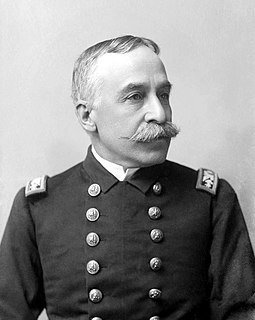
George Dewey was Admiral of the Navy, the only person in United States history to have attained that rank. He is best known for his victory at the Battle of Manila Bay during the Spanish–American War, with the loss of only a single crewman on the American side.
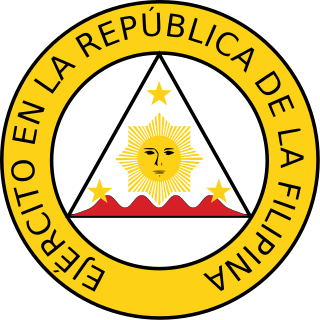
The Philippine Revolutionary Army later renamed Philippine Republican Army, was the official armed forces of the First Philippine Republic from its formation in March of 1899 to its disollution in November of that year in favor of guerilla operations in the Philippine–American War.

The Territory of Alaska or Alaska Territory was an organized incorporated territory of the United States from August 24, 1912, until Alaska was granted statehood on January 3, 1959. The territory was previously Russian America, 1784–1867; the Department of Alaska, 1868–1884; and the District of Alaska, 1884–1912.

Captain Arnold J. Isbell, USN was a United States Navy officer and Naval Aviator who was killed near the end of World War II.

Stephen Bleecker Luce was a U.S. Navy admiral. He was the founder and first president of the Naval War College, between 1884 and 1886.
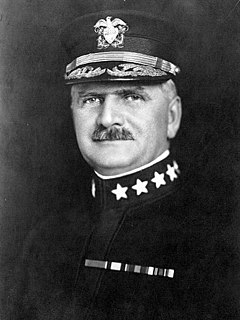
Robert Edward Coontz was an admiral in the United States Navy, who sailed with the Great White Fleet and served as the second Chief of Naval Operations.
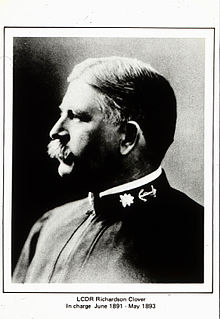
Richardson Clover was an officer of the United States Navy. An 1867 graduate of the United States Naval Academy, he was a noted hydrographer, served as Director of Naval Intelligence, and commanded the gunboat Bancroft during the Spanish–American War. He was socially prominent in Washington, D.C. and served as US Naval Attaché to Great Britain. He commanded the Wisconsin on the Asiatic Station and served as president of the Board of Inspection and Survey. He was promoted to rear admiral in 1907 and retired in 1908.

The Commander-in-Chief, The Nore, was an operational commander of the Royal Navy. His subordinate units, establishments, and staff were sometimes informally known as the Nore Station or Nore Command. The Nore is a sandbank at the mouth of the Thames Estuary and River Medway.

Henry Glass was a rear admiral in the United States Navy, best remembered for his role in the bloodless capture of Guam in the Spanish–American War. He was also a Union veteran of the American Civil War.
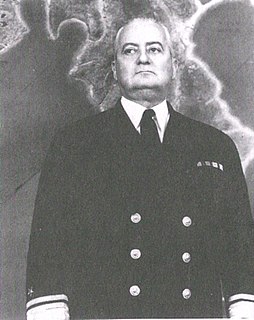
Robert Alfred Theobald, nicknamed "Fuzzy", was a United States Navy officer who served in World War I and World War II, and achieved the rank of rear admiral. In retirement, he was the author of the 1954 book The Final Secret of Pearl Harbor: The Washington Background of the Pearl Harbor Attack.

Uriel Sebree was a career officer in the United States Navy. He entered the Naval Academy during the Civil War and served until 1910, retiring as a rear admiral. He is best remembered for his two expeditions into the Arctic and for serving as acting governor of American Samoa. He was also commander-in-chief of the Pacific Fleet.
Robert Files Lopez was an officer in the United States Navy. He entered Annapolis with the Class of 1879, and he became the first Hispanic-American to graduate from the United States Naval Academy.

Commander, U.S. Fleet Forces Command (COMUSFF/COMFLTFORCOM) is the title of the United States Navy officer who serves as the commanding officer of the United States Fleet Forces Command. The U.S. Fleet Forces Command was originally established in 1905 as the U.S. Atlantic Fleet and as a two-star rear admiral's billet; the position has been held by a four-star admiral since March 10, 1915. The 45th, and current, commander of U.S. Fleet Forces Command is Admiral Daryl L. Caudle.

Thomas Benton Howard was a United States Navy officer who served as commander in chief of the U.S. Pacific Fleet prior to United States' entry into World War I.

Major General Joseph Henry Pendleton was a United States Marine Corps general for whom Marine Corps Base Camp Pendleton is named. Pendleton served in the Marine Corps for over 40 years.

Lester Anthony Beardslee was an officer in the United States Navy who served as the commander of the Department of Alaska and of USS Jamestown from June 14, 1879, to September 12, 1880.

Pearl Harbor is an American lagoon harbor on the island of Oahu, Hawaii, west of Honolulu. It was often visited by the Naval fleet of the United States, before it was acquired from the Hawaiian Kingdom by the U.S. with the signing of the Reciprocity Treaty of 1875. Much of the harbor and surrounding lands are now a United States Navy deep-water naval base. It is also the headquarters of the United States Pacific Fleet. The U.S. government first obtained exclusive use of the inlet and the right to maintain a repair and coaling station for ships here in 1887. The surprise attack by the Imperial Japanese Navy on December 7, 1941, led the United States to declare war on the Empire of Japan, making the attack on Pearl Harbor the immediate cause of the United States' entry into World War II.
Lieutenant is a commissioned officer rank in many nations' navies and coast guards. It is typically the most senior of junior officer ranks. In most navies, the rank's insignia may consist of two medium gold braid stripes, the uppermost stripe featuring an executive curl in many Commonwealth of Nations; or three stripes of equal or unequal width.
Henry Bertrand Price was a United States Navy Captain who served as the 30th Naval Governor of Guam. As a naval officer, he served on many assignments, including with the Bureau of Ordnance. In 1913, he became executive officer of USS Delaware, and two years later commanding officer of USS Melville. Becoming governor in 1923, Price focused on agricultural development, particularly in the region of Mangilao, Guam. He also ordered increased road building and the establishment of the Guam Department of Agriculture.

Andrews Avenue is a major east-west thoroughfare in Metro Manila, Philippines that functions as a metropolitan linkage between Pasay and Taguig. It runs underneath the NAIA Expressway almost parallel to Epifanio de los Santos Avenue (EDSA) to the north connecting Roxas Boulevard and Domestic Road near Bay City with South Luzon Expressway near Newport City. It has an arterial extension continuing 3.4 kilometers (2.1 mi) northeast to 5th Avenue and McKinley Road in Bonifacio Global City known as Lawton Avenue.















